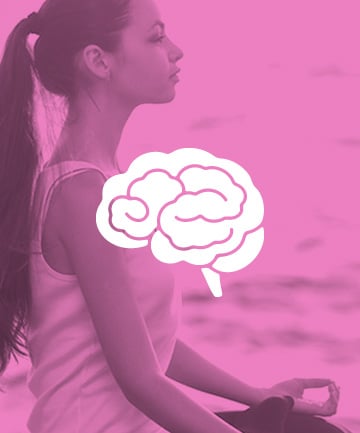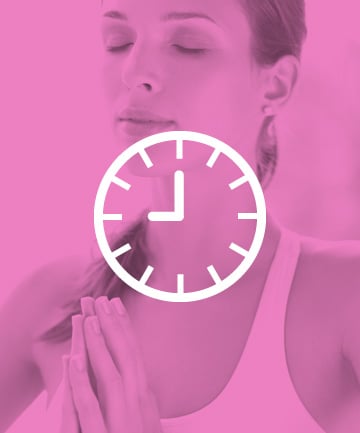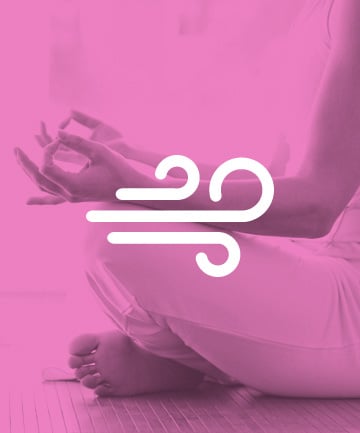While Bernstein says you can meditate anywhere -- "a park bench, at your desk, on the subway or in the bath" (seriously, anywhere!) -- she recommends that newbies create a quiet and clean meditation space in their homes that promotes a sense of calmness. As for the amount of time you should devote to your practice? When you're starting out, five to 10 minutes is all you need.
Whether you prefer to sit cross-legged on the floor or on a cushion, just make sure to relax your body and adapt better posture by lengthening your spine. Once you've made sure to release any tension in the body (specifically in the shoulders, neck and face), take a moment to be silent and still before tip-toeing into one of the following methods.
Whether you prefer to sit cross-legged on the floor or on a cushion, just make sure to relax your body and adapt better posture by lengthening your spine. Once you've made sure to release any tension in the body (specifically in the shoulders, neck and face), take a moment to be silent and still before tip-toeing into one of the following methods.
If you're always on the go, or it's one of those days where you're pressed for time, no worries. "Even one minute of meditation can have a great impact on your overall well-being," says Bernstein, who came up with this simple plan.
"Silence your mind and calm your energy," Bernstein advises. "Then, follow these steps for 60 seconds."
1) Breathe in for five seconds
2) Hold your breath for five seconds
3) Release your breath for five seconds
4) Hold the exhale for five seconds
"Silence your mind and calm your energy," Bernstein advises. "Then, follow these steps for 60 seconds."
1) Breathe in for five seconds
2) Hold your breath for five seconds
3) Release your breath for five seconds
4) Hold the exhale for five seconds
Mindfulness meditation (MM) has been around for thousands of years, and it helps us focus our attention on what's happening around us and live in the present moment. In addition to the benefits listed earlier, regular practice of MM can help us more objectively analyze ourselves and improve concentration.
In order to bring your mind and body together in the present, MM focuses on breath -- not necessarily controlling it, but being aware of each breath you take and how it connects with your body. One of the perks of practicing this form of meditation is that while it's always ideal to practice in a quiet, comfortable space, MM is practiced with the eyes open and is about letting your mind objectively flow through thoughts -- so not only is the set-up simple, you can practice for any length of time.
In order to bring your mind and body together in the present, MM focuses on breath -- not necessarily controlling it, but being aware of each breath you take and how it connects with your body. One of the perks of practicing this form of meditation is that while it's always ideal to practice in a quiet, comfortable space, MM is practiced with the eyes open and is about letting your mind objectively flow through thoughts -- so not only is the set-up simple, you can practice for any length of time.
Probably the most popular form of meditation in the U.S., according to Bernstein, transcendental meditation (TM) focuses on reaching a restful state of mind. Rather than being based in chanting or breath, TM is simply about transcending the thought process. You learn to relax the active mind (you know, that part of your brain that's running through the never-ending list of things you have to get done) and come into a state of calmness.
TM can be practiced anywhere that you are able to comfortably sit and close your eyes, without distraction, and it's recommended that you practice for 20 minutes, twice a day. While it may seem impossible to shut out that to-do list, to practice TM, all you have to do is think about focusing your attention inward and your mind will follow (much like when you get drawn into a good book or movie). You can adopt a mantra if you choose, or sit quietly until your time is up (consider setting a timer), or you've reached a state of relaxation.
TM can be practiced anywhere that you are able to comfortably sit and close your eyes, without distraction, and it's recommended that you practice for 20 minutes, twice a day. While it may seem impossible to shut out that to-do list, to practice TM, all you have to do is think about focusing your attention inward and your mind will follow (much like when you get drawn into a good book or movie). You can adopt a mantra if you choose, or sit quietly until your time is up (consider setting a timer), or you've reached a state of relaxation.










